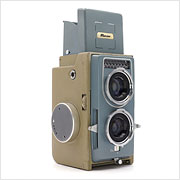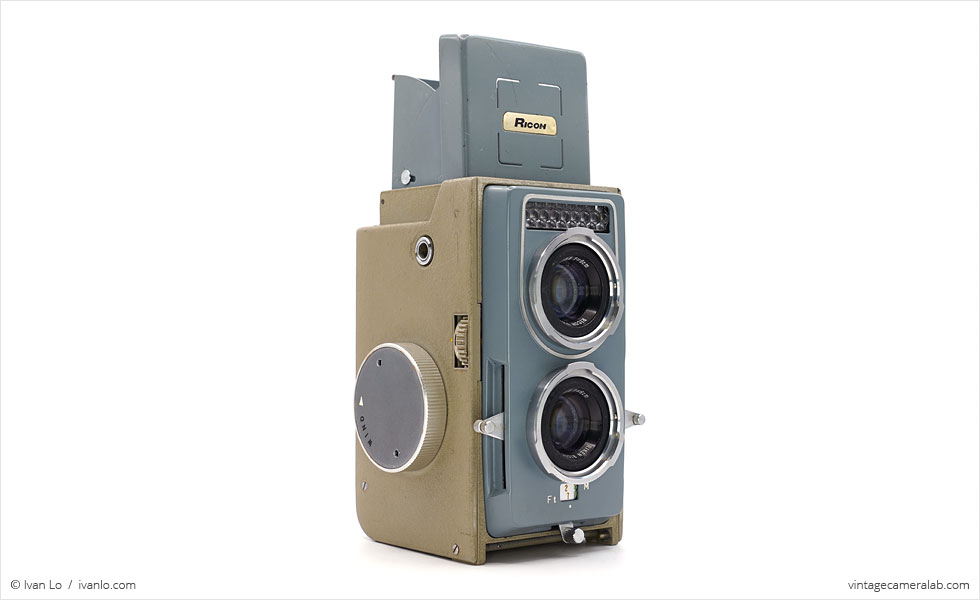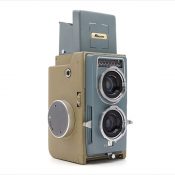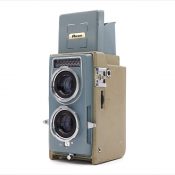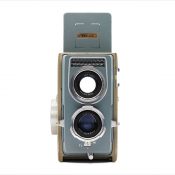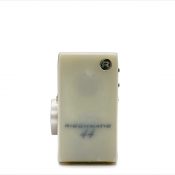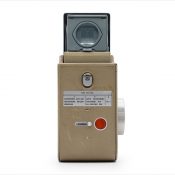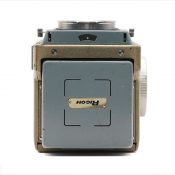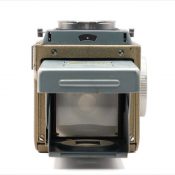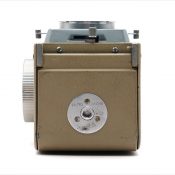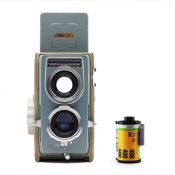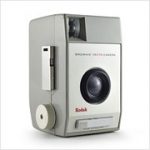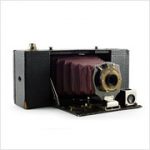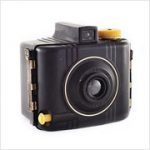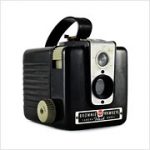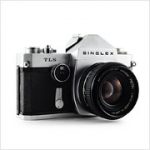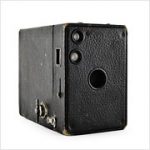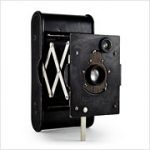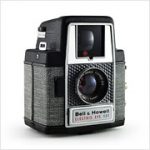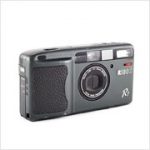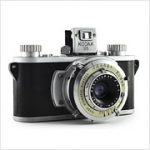Ricoh Ricohmatic 44 Specifications
| Manufacturer: | Riken Optical Co., Ltd. |
| Origin: | Japan |
| Made in: | Japan |
| Introduced: | 1959 |
| Type: | Twin Lens Reflex |
| Format: | 127 Film |
| Dimensions: | 7.4 x 12 x 8.1 cm |
| 7.4 x x 16.8 cm (viewfinder open) |
Ricoh Ricohmatic 44 Overview
The Ricoh Ricohmatic 44 is a compact twin lens reflex camera designed by the Riken Optical Company (now Ricoh) for 4x4cm exposures on 127 film. Like several of its contemporaries, the Ricohmatic 44’s color schemes (aside from this example’s grey-blue on beige, the camera also came in dark grey on beige and creme on beige) deviate from the standard black and silver palette in favor of something a bit more playful to set it apart from its larger, more serious 6x6cm siblings.
In the late 1950s, 127 film—a declining format that debuted decades earlier in 1912—was suddenly revitalized by the introduction of 4x4cm color slides. These 127 “Super Slides” were larger than their 35mm counterparts but, crucially, could still be played on the same projectors. Kodak, the primary supplier of this fashionable new film, conveniently complemented it with a new line of Brownie “Star” cameras including the Kodak Brownie Starlet, Kodak Brownie Starflash, and Kodak Brownie Starflex while other manufacturers also debuted brand new 127 cameras like the Ansco Cadet, Bell & Howell Electric Eye 127, and Bilora Bella 44.
With consumers eager to embrace the trend and a fresh wave of relatively inexpensive, easy to use cameras ready to meet demand, high-end German brand Rollei also carved a share of the rapidly growing market with the “Grey Baby” Rolleiflex 4×4, so nicknamed after its unorthodox color. Not content to sit idly by, several other brands launched their own high-quality 4x4cm twin lens reflex cameras in similarly non-traditional colors and varying levels of originality: the Minolta Miniflex, Yashica 44, Topcon Primo Jr., Walz Automat 44, and, of course, the Ricoh Ricohmatic 44.
Unlike its competition, the Ricohmatic 44 did not come with a traditional leather “Ever Ready” case but instead has a much sleeker bottom-hinged plastic case that flips open automatically when the viewfinder hood on the top is unfolded. Once opened, a magnifier can be flipped into place for fine tuning and the pair of lenses can be focused in tandem using the metal “wings” (which must be folded inward in order to put the cover on again) on either side of the bottom taking lens with a window beneath showing the distance scale in both feet and meters. To compose, two methods are available: either simply look down into the viewfinder or, with the magnifier flipped up, put one eye to the square cutout at the rear of the viewfinder hood to see through the frame lines cut into the metal around the Ricoh badge and keep the other eye open to see them superimposed onto the scene.
Once composed, check exposure settings using the light meter window located on top of the lens assembly. If the needle does not fall in the middle, adjust the recessed dial on the user’s right hand side of the camera until it does. A similar dial on the left hand side (beneath the hot shoe) will indicate what sort of film the camera is loaded with using the “film setting” chart beneath the latch that can be rotated counter-clockwise to release the film door. Once everything is set, use the shutter lever on the bottom of the front plate to take the photograph, then use the large winding knob on the right hand side to cock the shutter for the next exposure and also to advance the film. The next frame number should appear in the red window on the rear plate when done properly. A pair of strap connection sockets can be found on either side of the camera and a standard 1/4 inch tripod socket is located on the bottom.
With its unconventional colors and tasteful, modern design, it was only a matter of time before a Ricohmatic 44 ended up in my collection. I appreciate its solid, confidence-inspiring build quality from the finely machined latch on the film door to the strap lug sockets and also its clever (and probably cost-saving) solution of having superimposed frame lines in the sports finder. Luckily, my example is in very good condition with just a few minor scuffs and scratches along with a missing strap.
Find your very own Ricoh Ricohmatic 44 on eBay.
McKeown, James M. and Joan C. McKeown’s Price Guide to Antique and Classic Cameras, 2001-2002. (Grantsburg, WI, USA: Centennial Photo Service, 2001), p 331-332, 471, 568, 582, 702.
“Ricohmatic 44,” Camera Wiki, http://camera-wiki.org/wiki/Ricohmatic_44
